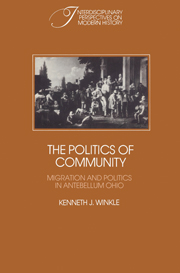Book contents
- Frontmatter
- Contents
- List of tables and figures
- Preface
- Introduction
- 1 The tide of emigration
- 2 An electorate in motion
- 3 From meeting to election: migration and suffrage
- 4 The defended community: migration and elections
- 5 “A movable column”: migration and voting
- 6 The core community: migration and leadership
- 7 Migration and local politics: an antebellum election
- Conclusion
- Notes
- Bibliography
- Index
1 - The tide of emigration
Published online by Cambridge University Press: 06 October 2009
- Frontmatter
- Contents
- List of tables and figures
- Preface
- Introduction
- 1 The tide of emigration
- 2 An electorate in motion
- 3 From meeting to election: migration and suffrage
- 4 The defended community: migration and elections
- 5 “A movable column”: migration and voting
- 6 The core community: migration and leadership
- 7 Migration and local politics: an antebellum election
- Conclusion
- Notes
- Bibliography
- Index
Summary
Like Americans in general, most Ohioans moved frequently during the nineteenth century, over long distances as part of the westward movement or in shorter moves within their own state. The antebellum decades were a period of buoyant economic growth, fueled by westward expansion, rapid advances in transportation, the rise of modern commercial cities, and an aggressive entrepreneurial ethos. Patterns of migration were therefore bound up with much broader social, economic, and cultural trends. In a complicated circular relationship, migration, westward expansion, urban growth, economic opportunity, and new transportation routes all contributed to and rested upon one another. Migration of some kind was a nearly universal experience before the Civil War, but it was not, of course, a uniform experience. Migration was often a very personal decision, and the characteristics and circumstances of specific individuals – their age, occupation, wealth, nationality, and even their personalities – influenced their decisions about when, where, and whether to move.
John Klippart was probably typical, but he was much more explicit than most migrants when explaining his reasons for moving, which he did frequently. Klippart, in fact, moved four times in one year. In 1846, Klippart was a teacher in a common school in Canton, Ohio, where he was born. At age 24, Klippart decided to leave teaching for a career in trade, to earn more money and start his own business.
- Type
- Chapter
- Information
- The Politics of CommunityMigration and Politics in Antebellum Ohio, pp. 11 - 29Publisher: Cambridge University PressPrint publication year: 1988



